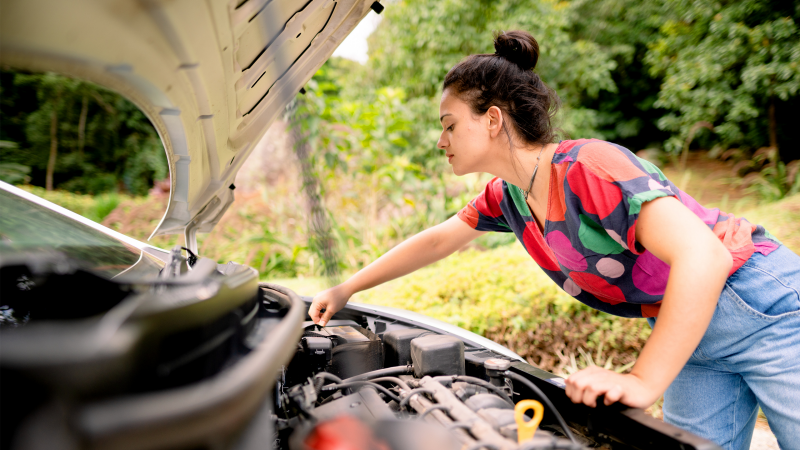A guide to your car battery

Any driver who’s ever needed a jump start due to a dead battery can tell you the importance of maintaining your car battery. It provides power to several crucial systems throughout your car, and without it, you’d be left with nowhere to go. Understanding your car battery — how it works, how to maintain it and how to pick out a new one — can help you avoid that unfortunate outcome.
How does a car battery work?
An automotive battery works much like the batteries you'd find in your home, using chemical energy to generate electricity. Your car battery’s most essential function is to power your car's starter, an electrical motor that kickstarts the engine before its combustion cycle kicks in. As you drive, the battery provides power to various other electrical systems throughout the car such as the lights, stereo and onboard computer. The battery also acts as a surge protector, stabilizing the voltage delivery throughout the car and recharging itself as you drive.
Common signs of a drained car battery
Car batteries typically have a lifespan of a few years. This can vary, however, based on environmental factors, your driving habits and the type of battery it is. There are a few common signs that may indicate that your car battery may be on its last legs:
- Slow engine start: If your engine feels sluggish when you attempt to start the car, possibly making some noise as it starts, it may be time to check your car battery.
- Low battery fluid level: Automotive batteries often have a translucent area on the casing that allows you to check the battery fluid levels. Fluid levels sometimes drop due to heat exposure, but if they look low, you may want to get your battery examined or replaced.
- “Check engine” light: The “check engine” dashboard light can come on for a variety of reasons, one of which may be weak or inconsistent power delivery from a battery that’s drained.
- Strange odor from battery: If you notice a pungent, sulfuric odor (like rotten eggs) near your car battery, you may have a leak. Leaks ruin your battery’s performance and potentially even corrode the nodes where you’d attach jumper cables.
- Battery is more than three years old: While many batteries can last beyond three years, a battery above this threshold is often considered an old timer. If your battery has reached this mark, it helps to have it inspected just to be safe.
Car battery maintenance tips
One way to help extend the life and performance of your car’s battery is to be proactive about its maintenance. Testing your battery at regular intervals (usually annually) is a good way to see how much life is left in your battery. This testing can be done by a mechanic, but you can also pick up a diagnostic tool at an auto parts store to help you do this yourself. These tools typically provide readings on the remaining charge, voltage, cranking and overall health to help you determine if it’s time to head to a garage for servicing or replace your battery altogether. Additionally, it helps to regularly check that your connectors and wires are in good shape and securely attached. Finally, follow any manufacturer recommendations regarding any car maintenance specifics in the owner’s manual of your car.
How to choose a car battery
If you find yourself in need of a new car battery, here are a few things to consider:
Car battery types
Car batteries come in two main types, lead-acid (sometimes called sealed lead-acid or SLA) and absorbed glass mat (AGM).
- Sealed Lead-Acid (SLA): Lead-acid batteries are the more traditional car batteries. Older varieties needed to occasionally be topped off with water, but modern versions are typically sealed off. These batteries are on the lower end of the car battery market.
- Absorbed Glass Mat (AGM): AGM batteries are newer, more advanced batteries that can stand up to more draining and recharging than standard SLA batteries. They’re typically more expensive but much more likely to recover from being drained out.
Battery size
Car batteries come in a variety of sizes, and it’s important to pick the one that fits your car properly. The terminals (where you connect the battery to your car) also need to be in the right alignment or your car’s cables may not reach or fit securely. It’s best to consult your owner’s manual to find out which sizes and terminal alignments the manufacturer recommends for your car.
Cold-cranking amps
Car batteries get weaker in colder weather. Cold-cranking amps (CCA) measure how well the battery can start an engine in extreme cold. Generally, the bigger the CCA number, the better.
Reserve capacity
Reserve capacity is a measure of how long the battery could power the car if its charging systems don’t work.
Battery life
Battery life is the measure of how many times the battery can be discharged and recharged before it fails to perform adequately. This is especially important to consider for drivers who frequently take short trips that don’t allow enough time to recharge properly.
Price
In general, more battery power — more CCAs, bigger reserve capacity, longer battery life — will cost more. Batteries aren’t exactly inexpensive, but they’re important enough to your car to consider investing in a higher-quality battery.
In summary
Without a car battery to power the starter, your car is quite literally going nowhere. You also wouldn’t be able to use your stereo, lights, headlights, navigation system or many other car systems that depend on the electric power from the battery. When a car battery starts to run low, you’ll notice the engine becoming slower to turn on. If there’s a leak, you may also notice a foul odor or corrosion around your battery. When looking for a replacement, it’s best to consult your owner’s manual to get the size and type of battery recommended by the manufacturer or visit a trusted mechanic.



